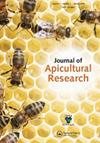蜂箱入口朝向对蜂群活动的影响
IF 1.8
4区 农林科学
Q2 ENTOMOLOGY
引用次数: 0
摘要
摘要为了确定蜂箱入口方向对蜂群活动和温度的影响,将蜂箱面向不同的基本方向(每个方向3-5个蜂箱)。每5次记录蜂巢重量 每30分钟和温度 2019年4月至2020年6月的分钟数。日体重数据采用分段回归分析。在亚利桑那州南部,从12月到3月,面向东部的蜂箱开始了每天的飞行活动50 比蜂箱向西提前几分钟并结束飞行活动57 比蜂箱朝南早了几分钟。在这段时间里,朝东的蜂箱每天的蜂箱重量损失最低,62 g/d,而100 朝北蜂箱每天克。朝东的蜂箱也有7个 平均比向西的蜂箱低°C,这表明蜂箱重量减轻的原因是食物消耗减少,这与较低的蜂群温度直接相关。从12月到3月,由于觅食者的离开,朝东的蜂箱早上的体重减轻幅度也明显低于朝北的蜂箱(表明觅食者更多),但从2020年4月到6月,体重减轻幅度更大。大多数影响发生在12月至3月,可能是由于白天时间有限和环境温度较低。对肉眼估计的成年蜜蜂数量(蜜蜂的框架)或密封窝的表面积没有观察到显著影响。我们建议在设计涉及监测菌落活动的田间实验时考虑蜂巢方向。本文章由计算机程序翻译,如有差异,请以英文原文为准。
Effects of hive entrance orientation on honey bee colony activity
Abstract In an effort to determine the effects of the orientation of hive entrance on honey bee colony activity and temperature, hives were placed facing different cardinal directions (3–5 hives per direction). Hive weight was recorded every 5 minutes and temperature every 30 minutes from April 2019 to June 2020. Daily weight data were analyzed using piecewise regression. In southern Arizona from December to March, hives facing east started daily flight activity 50 minutes earlier than hives facing west and ended flight activity 57 minutes earlier than hives facing south. During that period east-facing hives had the lowest daily hive weight loss, 62 g per d compared to 100 g per d for north-facing hives. East-facing hives were also about 7 °C cooler on average than west-facing hives, suggesting that lower hive weight loss was due to lower food consumption which was directly related to lower colony cluster temperatures. From December to March hives facing east also had significantly lower morning weight loss due to departing foragers than hives facing north (indicating more foragers) but higher weight loss from April to June 2020. Most effects were observed from December to March, probably due to restricted daylight hours and lower ambient temperatures. No significant effects were observed with respect to visually-estimated adult bee numbers (frames of bees) or the surface areas of the sealed brood. We recommend hive orientation be taken into account in the design of field experiments that involve monitoring colony activity.
求助全文
通过发布文献求助,成功后即可免费获取论文全文。
去求助
来源期刊
CiteScore
4.80
自引率
10.50%
发文量
111
审稿时长
6-12 weeks
期刊介绍:
The Journal of Apicultural Research is a refereed scientific journal dedicated to bringing the best research on bees. The Journal of Apicultural Research publishes original research articles, original theoretical papers, notes, comments and authoritative reviews on scientific aspects of the biology, ecology, natural history, conservation and culture of all types of bee (superfamily Apoidea).

 求助内容:
求助内容: 应助结果提醒方式:
应助结果提醒方式:


